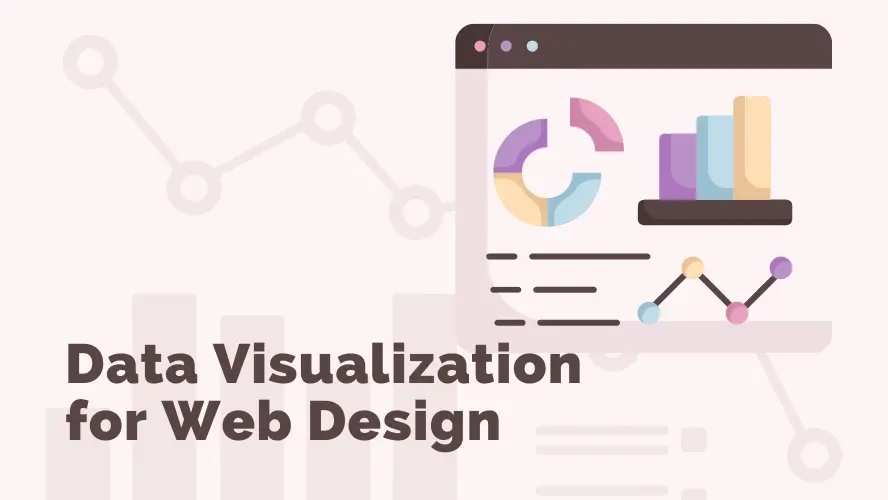Data visualization web design is the art and practice of designing web pages and applications that communicate data in a visually appealing and informative way. It involves using various techniques, such as charts, graphs, and infographics, to present data in a way that is easy for users to understand and interpret.
This article will give you an overview of why data visualization is important for some types of websites and how to create effective and informative data visualization with the right tools for a website.
The Importance of Data Visualization for Web Design
Data visualization is an important part of web design because it can help users to:
- Get a quick overview of complex data sets Users can quickly see patterns and trends in data that would be difficult to discern from raw numbers or text. This is because they present data in a way that is easy for the human brain to process.
- Identify key insights Data visualization can help users identify key insights in data that they may not have noticed otherwise.
- Make informed decisions It helps users to make informed and effective decisions based on the data. This is because they allow users to quickly see the relationships between different data points and identify patterns and trends.
- Improved user engagement Data visualizations can be more engaging than traditional text-based presentations of data. This is because they allow users to explore data at their own pace and discover insights that they may not have seen otherwise.
- Boosted brand awareness It can help businesses and organizations to boost their brand awareness. This is because it allows them to showcase their expertise in a visually appealing and informative way.
What Types of Websites That Should Use Data Visualization?
Data visualization web design is an important part of many different types of websites, including:
News and media websites Data visualization in news and media websites is useful for presenting complex data in a way that is easy for readers to understand. For example, a news website might use a chart to show the results of a recent election or a graph to show the trend of COVID-19 cases in a particular region.
Business websites Business websites can use data visualization to communicate their products and services to potential customers. A business website might use a chart to show how their product compares to the competition or a graph to show how their sales have grown over time.
Government websites Data visualization for the government websites would be able to communicate information about government programs and policies to citizens. A government website might use a map to show the location of different government offices or a chart to show how the government's budget is spent.
E-commerce websites E-commerce websites use data visualization to help customers find and purchase products. An e-commerce website might use a product recommendation engine to suggest products to customers based on their past purchases or a price comparison chart to help customers compare the prices of different products.
Educational websites Educational websites can make learning more engaging and effective using data visualization. An educational website might use a timeline to show the history of a particular topic or a diagram to explain a complex scientific concept for example.
Nonprofit websites Nonprofit websites use data visualization to communicate the impact of their work to donors and supporters. For example, a nonprofit website might use a chart to show the number of people they have helped or a map to show the locations where they operate.
The Principles of Data Visualization for Web Design
When designing web pages and applications that use data visualization, it is important to remember the following principles:
Simplicity & Clarity Data visualization is highly recommended to be simple and easy to understand. Avoid using too many complex charts or graphs, and focus on presenting the data clearly and concisely. The design of data visualizations should be clear and easy to interpret.
Communicative What is the most important thing you want users to take away from your data visualization? Identify the message you wish to convey. Make sure the visualization is designed to communicate that message clearly and effectively.
Accuracy Accurate, truthful, and up-to-date data visualization is preferable for users or web visitors. Make sure to verify the data before creating any visualizations, and keep the visualizations updated as the data changes. Avoid using misleading or deceptive techniques to make your data look better than it is.
Interactivity Data visualizations should be interactive whenever possible. This allows users to explore the data at their own pace and discover insights that they may not have seen otherwise. Use colors, fonts, and other design elements to create an informative and engaging visualization.
Tips for Effective Data Visualization for Web Design
Data visualization is important because it is a powerful tool for communicating complex information clearly and concisely. Here are some additional tips for designing effective data visualizations for the web:
Choose the right visualization for the data There are many different types of data visualizations, so it is important to choose the right one for the data you are trying to communicate. For example, a line chart may be the best option if you are trying to show trends over time. If you are trying to compare different categories of data, a bar chart or pie chart may be more effective.
Audience Identification Who are you designing your data visualizations for? Tailor the visualization to their needs and interests. For example, if you are designing a data visualization for a technical audience, you can use more complex charts and graphs.
Appropriate Data Amount Never overload your visualizations with too much data. This will only make them difficult to understand. Instead, focus on displaying the most important and relevant data.
Use color and symbols effectively Color and symbols can be used to highlight key insights, and trends to make the data more visually appealing. However, avoid using too many colors which potentially confuses users.
Label everything clearly Make sure to label all axes and data points clearly. This will help users to understand the data and identify key insights.
Make it accessible Make sure your data visualizations are accessible to users with disabilities. Use text equivalents for all images and charts, and provide alternative formats for users who cannot see your data visualizations.
Additionally use relative units, CSS, or JavaScript libraries that allow your data visualizations to scale to different screen sizes as responsive components in web design. This is especially important as more and more people are using their smartphones and tablets to access the internet.
Types of Data Visualization for Web Design
There are an enormous number of data visualization types, yet these are the most common types in web design, along with example pictures:
Charts and Graphs
Bar chart A bar chart uses bars to represent data and is often used to compare different categories of data.
Line chart A line chart uses lines to represent data and is often used to show trends over time.
Pie chart A pie chart uses pie slices to represent data and is often used to show data distribution within a category.
Scatter plot A scatter plot uses dots to represent data and is often used to show the relationship between two variables.
Histogram A histogram is a type of data visualization that shows the distribution of data within a continuous range.
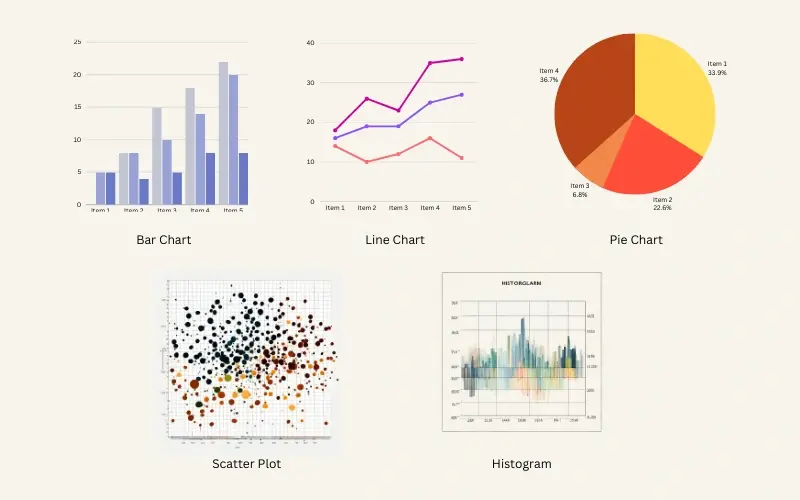
Infographics and Dashboards
- Infographic An infographic uses text, images, and charts to present information in a visually appealing and informative way. Infographics are often used to communicate complex data in a way that is easy for people to understand.
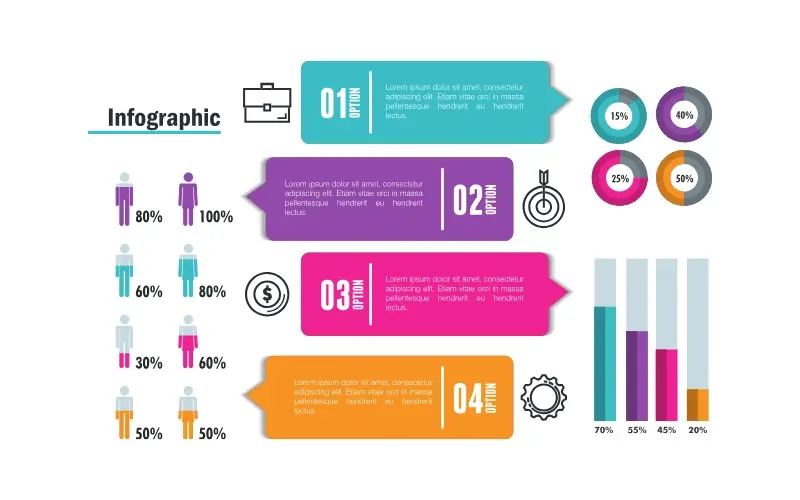
- Dashboard
A dashboard provides a real-time overview of key performance indicators (KPIs). Dashboards are often used in business intelligence applications to track progress toward goals and identify areas for improvement.
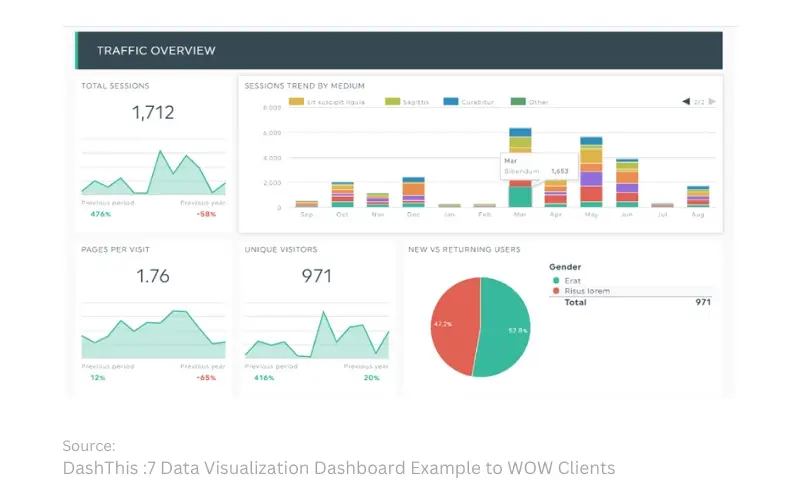
Maps and geographic visualizations:
- Choropleth map A choropleth map uses colors to represent data on a geographic map. Choropleth maps are often used to show the distribution of data across a region.
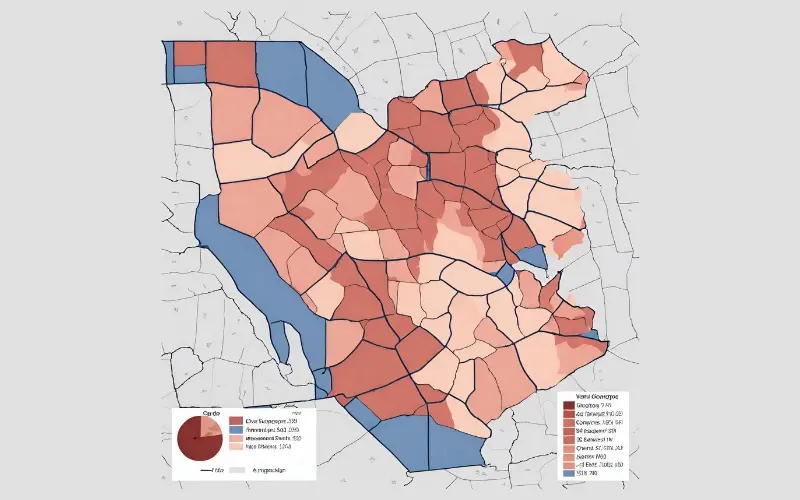
- Heatmap A heatmap uses colors to represent the density of data in a geographic area. Heatmaps are often used to identify clusters or hotspots of data.
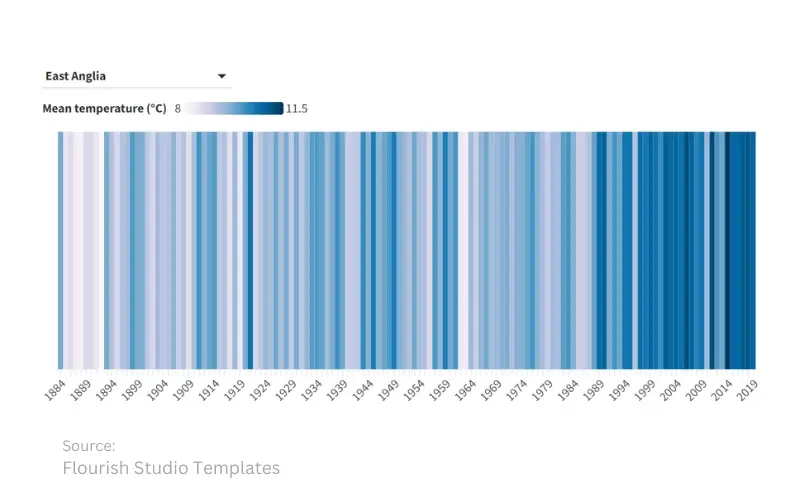
Network visualizations:
- Network graph A network graph represents relationships between data points. Network graphs are often used to visualize social networks, communication networks, and transportation networks.
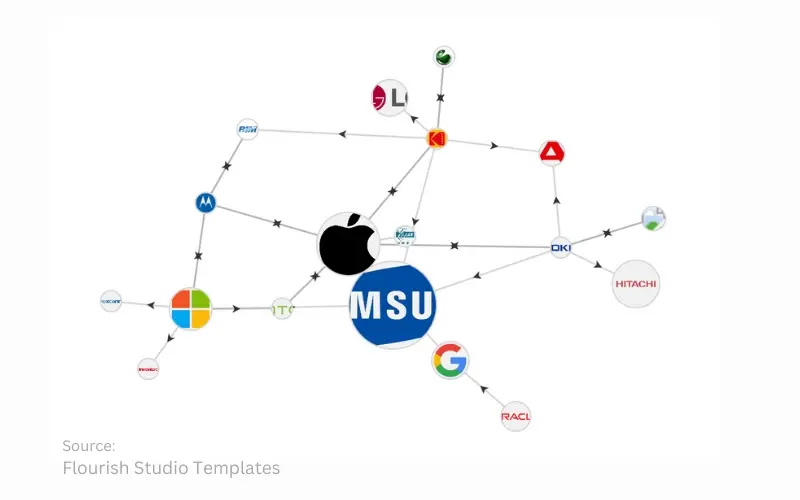
Time series visualizations:
- Timeline A timeline shows a sequence of events over time. Timelines are often used to visualize historical data or to track the progress of a project.
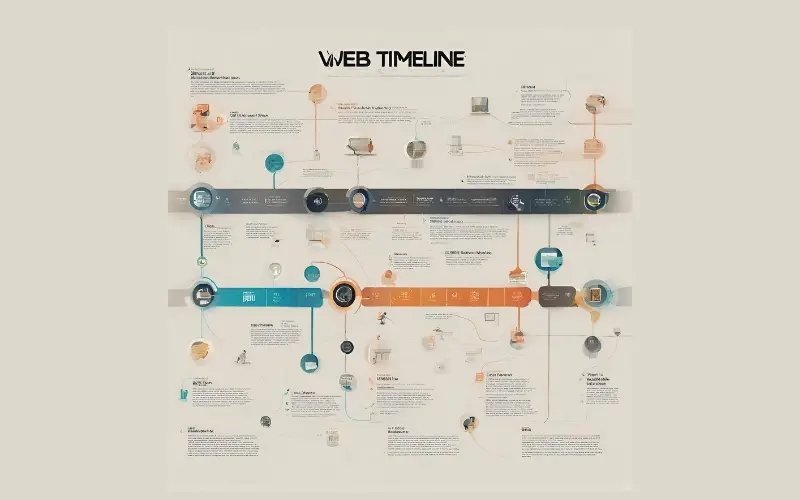
- Gantt Chart A Gantt chart is a type of bar chart that illustrates a project schedule or timeline, which is commonly used in project management to track the progress of tasks and identify potential delays.
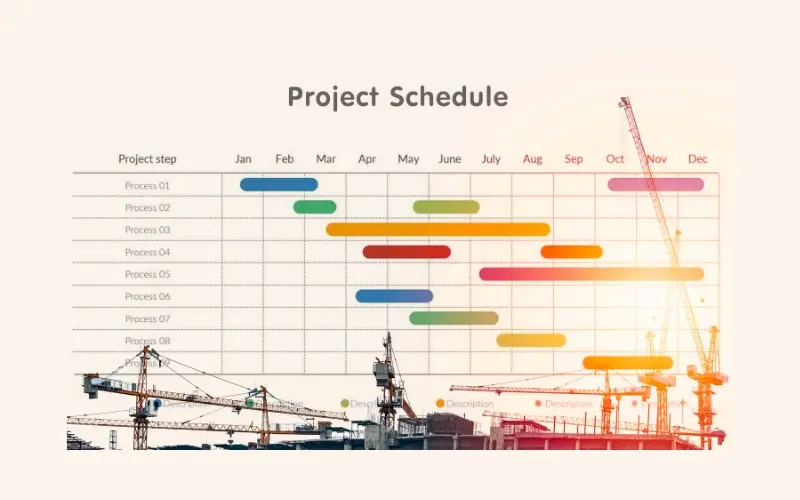
Tools to Create Data Visualization for Web Design
Data visualization tools may offer various pre-made charts or templates to help you produce astonishing data visualization on your websites. They are customizable and provide different options to share the data visualization. Here are recommended data visualization tools that are relatively simple for you to try:
Canva
Canva is a general-purpose design platform that offers a wide range of features, including data visualization. You can find many types of data visualization charts, diagrams, and infographic design templates to start creating.
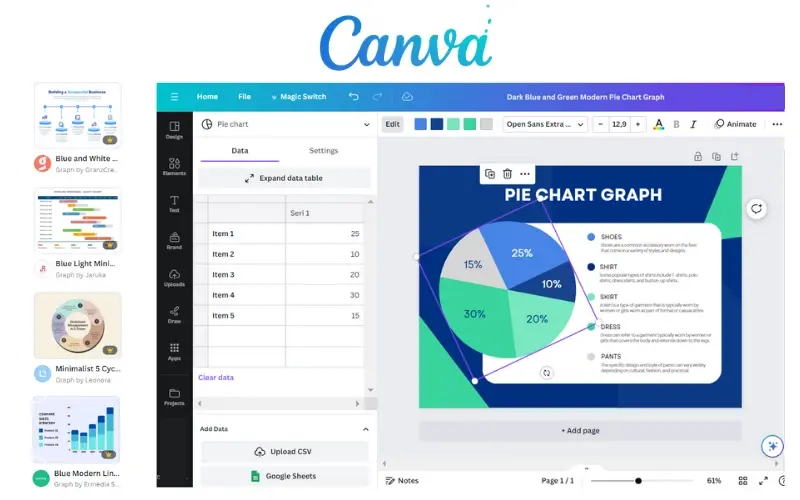
Pros and Cons of Canva
Pros
Cons
Graphy
Graphy is the best tool to start with if you are looking for easy yet simple and modern look data visualization. It allows you to customize data visualization from the ready-to-use provided data table quickly.
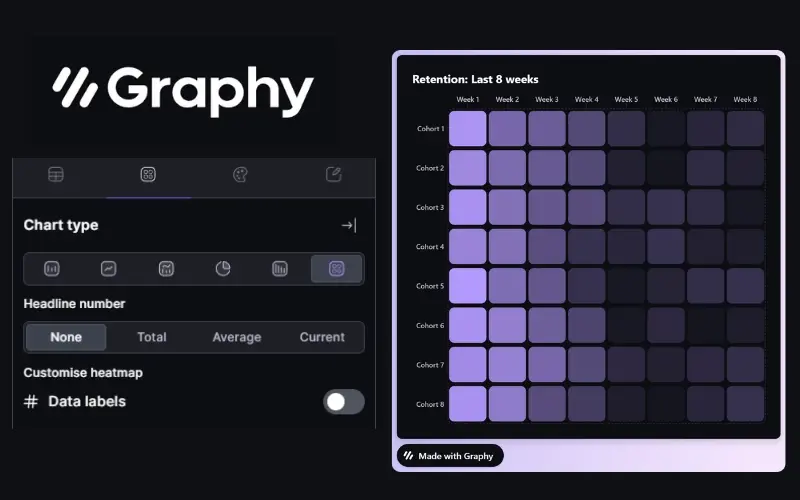
Pros and Cons of Graphy
Pros
Cons
Flourish
It’s an online tool that allows you to explore and explain data with beautiful visualizations and stories. You can just publish, present in a slideshow, or download the data visualization without the need to code or install any software.

Pros and Cons of Flourish
Pros
Cons
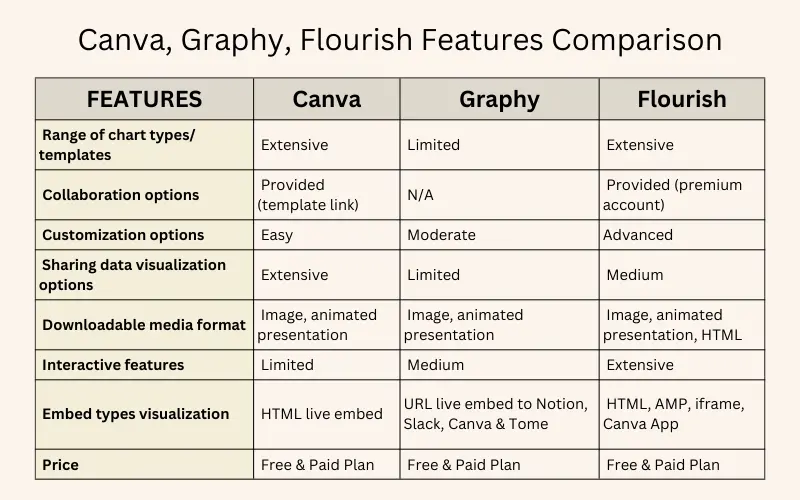
Conclusion
Data visualization for web design is a process of using visual elements to communicate data clearly and concisely. It is a field that combines web design, data science, and storytelling. Effective data visualization can help people understand patterns, trends, and relationships that would be difficult to see in the raw data. It can be used to improve understanding, identify patterns and trends, make better decisions, and persuade others.
For those using Redaxscript CMS, consider our specialized Redaxscript Hosting. With advanced LiteSpeed Webserver technology and a user-friendly cPanel, our hosting delivers the essential tools needed for optimal performance, ensuring both speed and security for your Redaxscript projects.
Frequently Asked Questions
How do I choose a design for my website?
One of the most important things when creating a website for your art is the design. Even though your pieces of art might be amazing, people will leave if your site is hard to navigate. This is why it’s important that the site is easy on the eyes and easy to navigate.
How is the website maintenance carried out?
On a daily basis, software, hardware, vulnerability, MariaDB, CloudLinux paths and cPanel updates are carried out on our servers without a reboot. However, if we have to carry out any maintenance that includes some downtime, we schedule in advance and update our status page
What are the customization options with a website builder?
Although website builders usually have some customization settings, like templates, fonts, margins editing, and so on, when compared to CMSs, it lacks customization options.
Will you be able to fully restore the website if something goes wrong?
Should anything happen, your website can be restored fully with the help of JetBackup5

Audee Mirza is a graphic designer and WordPress developer at audeemirza.com who resides in Surabaya, Indonesia. She's also the author of Graphic Identity Blog, a professional logo designer, and often creates vector illustrations for clients and marketplaces. She enjoys good typography design and all kinds of animation.
View all posts by Audee Mirza















